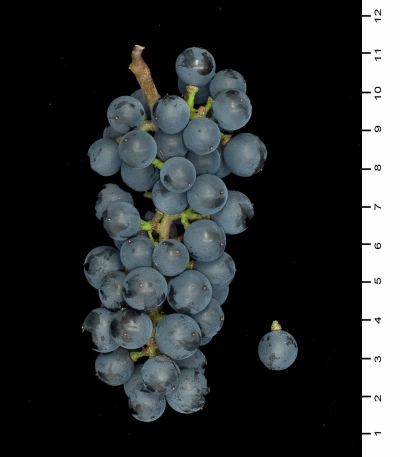
- Authors: Maurice Baco, France
- Appointment: technical
- Berry color: black, with a thick waxy coating
- Taste: pleasant, with a peculiar varietal aroma
- Frost resistance, ° C: -27
- Name synonyms: Bako # 1, Bako 1-24, Bako 24-23, Bako space, Bako black
- Bunch weight, g: 150-200
- Density of the bunch: loose
- Appeared when crossing: Folle Blanche x Vitis Riparia
- Berry shape: round
Many grape varieties are table grapes, but there are also technical varieties. An excellent representative of the technical variety is the Bako hybrid. Having an exquisite taste, it is loved by many winemakers. In this article, we will consider the history of breeding, features of the variety and cultivation.
Breeding history
The grape is named after its creator, the Frenchman Maurice Bako. The breeder took two grape varieties as a basis, namely Folle Blanche and Vitis Riparia. The hybrid is of Franco-American origin, it also has other names:
Tank # 1;
Bako black;
Bako speysky;
Bako 1-24, Bako 24-23.
In the Soviet Union, this species could be found under completely different names: Timofeyevka and Alzheryan.
Description
The grape bushes are very attractive in appearance, they are medium-sized, in warm climates they can begin to grow actively. The average length of the vine is 12-17 m, the thickness of one branch is approximately 20 mm. The leaves are lush, five-pointed, rounded, with subtle lobes. There are no villi on the back. Their length is 25-30 cm. The leaves cover the bunches very strongly, but this does not interfere with the ripening of the grapes.
Ripening period
Since this hybrid belongs to a technical variety, it picks up color quite early, somewhere in the middle of May, but its vegetative period is long. The first fruits ripen only in the last weeks of September. That is, on average, between the beginning of flowering and the first fruits, it takes from 120 days to 140 days.
Bunches
The bunches are medium, there are also small ones. They are cylindrical-conical in shape, slightly elongated. By weight, one bunch reaches 150-200 g. The stem is tightly pressed to the vine, medium in length. Fruits on the cluster grow loosely to each other.
Berries
The berries are black and round. The size is closer to the average, but there are also small berries. Size from 7 to 9 mm. The rind is thin, very fragile, and cracks easily. Has a barely noticeable gloss and a dense waxy coating. The pulp is firm and juicy.
Taste
The berries are very pleasant to the taste, not sugary. There is a peculiar aroma. The juice itself has a dark ruby hue due to the fact that it mixes with the peel, but after infusion it becomes transparent.
Due to the fact that technical grape varieties are often grown for wine, they contain an increased acidity, which is not very pronounced when eaten.
Yield
The yield of this hybrid is very high. True, a lot depends on climatic and weather conditions: if the year was cold, then the harvest will be poor.


Growing features
The main feature of growing the species is that Bako loves heavy clay soils. If the soil is too fertilized, soft and loose, then in this case the shoots will begin to grow excessively and can grow up to 8 m in length during the season.
Landing
The planting of technical varieties is slightly different from the table varieties and is considered quite simple to perform. It is because of planting that the berries usually ripen small.
The distance between the bushes should be 1.5-2 m, and it is better to leave 2 m between the rows.
It is worth digging a hole a little more than the diameter of the roots. This is approximately 0.8 m. At the bottom of the hole, it is worth putting humus in small quantities, covering it with earth, then planting a seedling and filling the hole, gradually tamping the earth. Spill with water.
In the early years, you can feed the seedlings a little with growth stimulants so that they take root well. Do not overdo it with this.

Pollination
The Bako hybrid does not need additional pollination, since its flowers are of both sexes, and it is considered a self-pollinated species.
Pruning
Pruning is done in spring and autumn in the southern regions, and in colder ones only in summer. Of course, before the season, it is worth inspecting the bushes, and cutting off all dried branches: those that did not leave after winter, and those that are susceptible to disease. For a home garden (not plantations), on average, the vine is left 10-12 m long, attached to the trellises. The supports themselves should be approximately 0.5 m higher. It can be planted near arches or arbors, then the grapes will twine on their own.



Frost resistance and the need for shelter
It tolerates frosts down to -27 degrees. But since the place of creation is considered to be a more southern region, it is still necessary to cover the plant for the winter so that in the spring all the bushes thaw normally.

Diseases and pests
The hybrid was created for resistance to various fungal diseases. Indeed, in France, vineyards have often been exposed to outbreaks of fungal diseases such as phylloxera. But it is still worth carrying out preventive spraying once a season.

If a grape is exposed to any disease or insect, this always affects its appearance.
Storage
This variety is produced more for making juices or wines than for eating raw. Therefore, this species has a good shelf life and transportation.
Bako is usually kept in boxes. Paper is laid on the bottom, covered with a small layer of sawdust 2-3 cm. Then the grapes are laid out, sprinkled with sawdust with a layer of 5 cm. And again the grapes are laid out. This is to prevent the grape skins from bursting.











































































